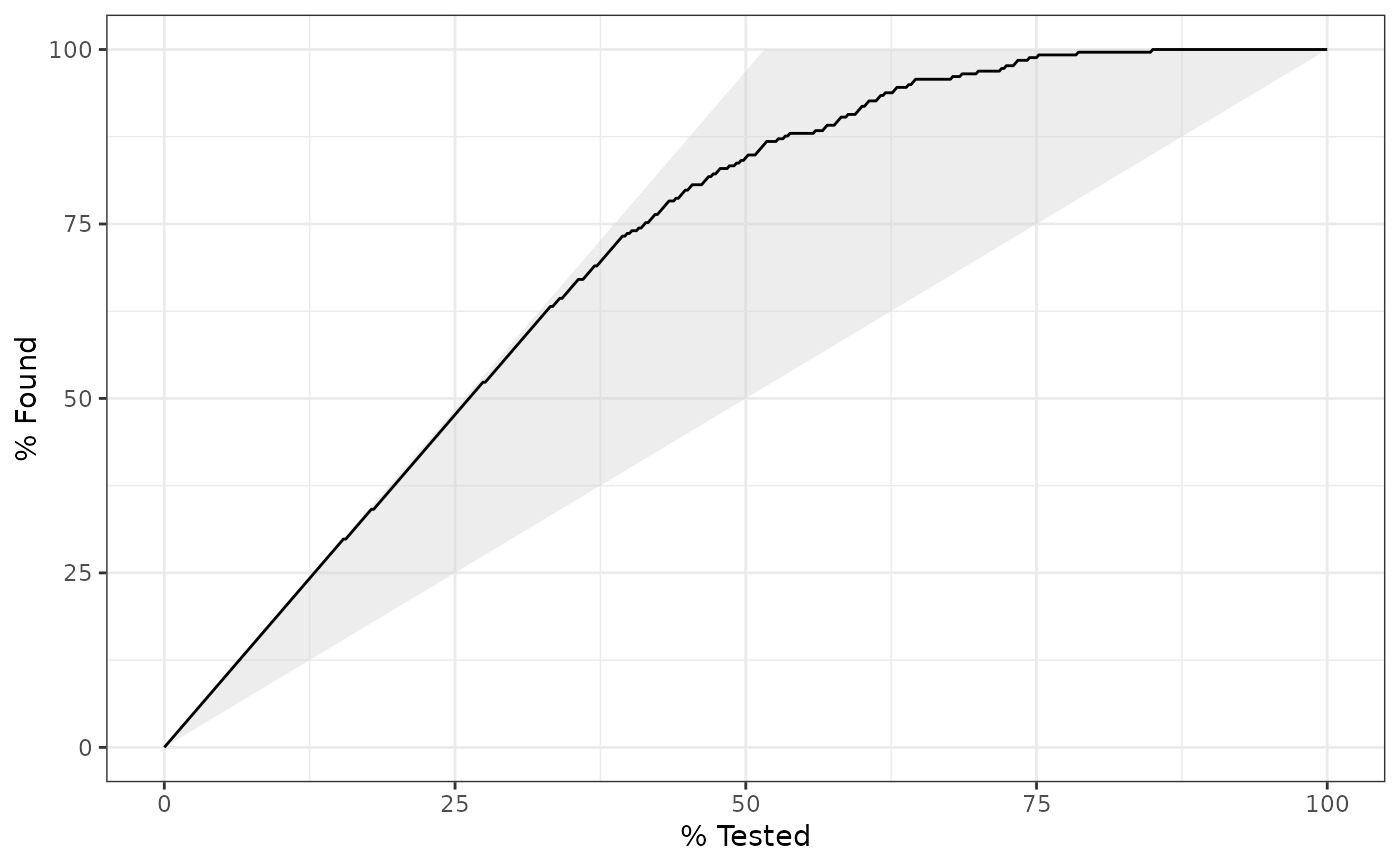gain_capture() 是类似于 AUC 计算的性能度量,但应用于增益曲线。
用法
gain_capture(data, ...)
# S3 method for data.frame
gain_capture(
data,
truth,
...,
estimator = NULL,
na_rm = TRUE,
event_level = yardstick_event_level(),
case_weights = NULL
)
gain_capture_vec(
truth,
estimate,
estimator = NULL,
na_rm = TRUE,
event_level = yardstick_event_level(),
case_weights = NULL,
...
)参数
- data
-
包含
truth和...指定的列的data.frame。 - ...
-
一组不带引号的列名称或一个或多个
dplyr选择器函数,用于选择哪些变量包含类概率。如果truth是二进制,则仅应选择 1 列,并且它应对应于event_level的值。否则,列的数量应与truth的因子级别一样多,并且列的顺序应与truth的因子级别相同。 - truth
-
真实类结果的列标识符(即
factor)。这应该是一个不带引号的列名,尽管此参数是通过表达式传递的并且支持quasiquotation(您可以不带引号的列名)。对于_vec()函数,一个factor向量。 - estimator
-
"binary"、"macro"或"macro_weighted"之一指定要完成的平均类型。"binary"仅与两类情况相关。另外两个是计算多类指标的通用方法。默认会根据truth自动选择"binary"或"macro"。 - na_rm
-
logical值,指示在计算继续之前是否应剥离NA值。 - event_level
-
单个字符串。
"first"或"second"指定将truth的哪个级别视为"event"。此参数仅适用于estimator = "binary"。默认使用内部帮助程序,通常默认为"first",但是,如果设置了已弃用的全局选项yardstick.event_first,则将使用该帮助程序并发出警告。 - case_weights
-
案例权重的可选列标识符。这应该是一个不带引号的列名称,其计算结果为
data中的数字列。对于_vec()函数,一个数值向量。 - estimate
-
如果
truth是二进制的,对应于 "relevant" 类的类概率的数值向量。否则,矩阵的列数与因子级别一样多truth.假设它们的顺序与truth的级别相同。
值
tibble 包含列 .metric 、 .estimator 和 .estimate 以及 1 行值。
对于分组 DataFrame ,返回的行数将与组数相同。
对于 gain_capture_vec() ,单个 numeric 值(或 NA )。
细节
gain_capture() 计算增益曲线下方但基线上方的面积,然后除以完美增益曲线下方但基线上方的面积。它旨在表示模型的潜在增益"captured"。
gain_capture() 指标与准确率 (AR) 相同,有时也称为基尼系数。这两者通常是在累积精度剖面曲线上计算的,但这与增益曲线相同。有关详细信息,请参阅 Engelmann 引用。
相关级别
在计算二元分类指标时,对于哪个因子级别应自动被视为 "event" 或 "positive" 结果,没有通用约定。在 yardstick 中,默认使用第一级。要更改此设置,请将参数 event_level 更改为 "second" 以将因子的最后一个级别视为感兴趣级别。对于涉及 one-vs-all 比较(例如宏平均)的多类扩展,此选项将被忽略,并且 "one" 级别始终是相关结果。
多级
此指标可使用宏观平均和宏观加权平均。如果提供了超过 2 个级别的 truth 因子,则默认选择宏平均。否则,将进行标准二进制计算。有关详细信息,请参阅vignette("multiclass", "yardstick")。
也可以看看
gain_curve() 计算完整增益曲线。
其他类概率指标:average_precision() , brier_class() , classification_cost() , mn_log_loss() , pr_auc() , roc_auc() , roc_aunp() , roc_aunu()
例子
# ---------------------------------------------------------------------------
# Two class example
# `truth` is a 2 level factor. The first level is `"Class1"`, which is the
# "event of interest" by default in yardstick. See the Relevant Level
# section above.
data(two_class_example)
# Binary metrics using class probabilities take a factor `truth` column,
# and a single class probability column containing the probabilities of
# the event of interest. Here, since `"Class1"` is the first level of
# `"truth"`, it is the event of interest and we pass in probabilities for it.
gain_capture(two_class_example, truth, Class1)
#> # A tibble: 1 × 3
#> .metric .estimator .estimate
#> <chr> <chr> <dbl>
#> 1 gain_capture binary 0.879
# ---------------------------------------------------------------------------
# Multiclass example
# `obs` is a 4 level factor. The first level is `"VF"`, which is the
# "event of interest" by default in yardstick. See the Relevant Level
# section above.
data(hpc_cv)
# You can use the col1:colN tidyselect syntax
library(dplyr)
hpc_cv %>%
filter(Resample == "Fold01") %>%
gain_capture(obs, VF:L)
#> # A tibble: 1 × 3
#> .metric .estimator .estimate
#> <chr> <chr> <dbl>
#> 1 gain_capture macro 0.743
# Change the first level of `obs` from `"VF"` to `"M"` to alter the
# event of interest. The class probability columns should be supplied
# in the same order as the levels.
hpc_cv %>%
filter(Resample == "Fold01") %>%
mutate(obs = relevel(obs, "M")) %>%
gain_capture(obs, M, VF:L)
#> # A tibble: 1 × 3
#> .metric .estimator .estimate
#> <chr> <chr> <dbl>
#> 1 gain_capture macro 0.743
# Groups are respected
hpc_cv %>%
group_by(Resample) %>%
gain_capture(obs, VF:L)
#> # A tibble: 10 × 4
#> Resample .metric .estimator .estimate
#> <chr> <chr> <chr> <dbl>
#> 1 Fold01 gain_capture macro 0.743
#> 2 Fold02 gain_capture macro 0.727
#> 3 Fold03 gain_capture macro 0.796
#> 4 Fold04 gain_capture macro 0.748
#> 5 Fold05 gain_capture macro 0.730
#> 6 Fold06 gain_capture macro 0.754
#> 7 Fold07 gain_capture macro 0.730
#> 8 Fold08 gain_capture macro 0.747
#> 9 Fold09 gain_capture macro 0.710
#> 10 Fold10 gain_capture macro 0.731
# Weighted macro averaging
hpc_cv %>%
group_by(Resample) %>%
gain_capture(obs, VF:L, estimator = "macro_weighted")
#> # A tibble: 10 × 4
#> Resample .metric .estimator .estimate
#> <chr> <chr> <chr> <dbl>
#> 1 Fold01 gain_capture macro_weighted 0.759
#> 2 Fold02 gain_capture macro_weighted 0.745
#> 3 Fold03 gain_capture macro_weighted 0.811
#> 4 Fold04 gain_capture macro_weighted 0.734
#> 5 Fold05 gain_capture macro_weighted 0.733
#> 6 Fold06 gain_capture macro_weighted 0.730
#> 7 Fold07 gain_capture macro_weighted 0.737
#> 8 Fold08 gain_capture macro_weighted 0.730
#> 9 Fold09 gain_capture macro_weighted 0.681
#> 10 Fold10 gain_capture macro_weighted 0.737
# Vector version
# Supply a matrix of class probabilities
fold1 <- hpc_cv %>%
filter(Resample == "Fold01")
gain_capture_vec(
truth = fold1$obs,
matrix(
c(fold1$VF, fold1$F, fold1$M, fold1$L),
ncol = 4
)
)
#> [1] 0.7428922
# ---------------------------------------------------------------------------
# Visualize gain_capture()
# Visually, this represents the area under the black curve, but above the
# 45 degree line, divided by the area of the shaded triangle.
library(ggplot2)
autoplot(gain_curve(two_class_example, truth, Class1))

相关用法
- R yardstick gain_curve 增益曲线
- R yardstick pr_auc 查准率曲线下面积
- R yardstick accuracy 准确性
- R yardstick pr_curve 精确率召回曲线
- R yardstick conf_mat 分类数据的混淆矩阵
- R yardstick mn_log_loss 多项数据的平均对数损失
- R yardstick rpd 性能与偏差之比
- R yardstick mae 平均绝对误差
- R yardstick detection_prevalence 检测率
- R yardstick bal_accuracy 平衡的精度
- R yardstick rpiq 绩效与四分位间的比率
- R yardstick roc_aunp 使用先验类别分布,每个类别相对于其他类别的 ROC 曲线下面积
- R yardstick roc_curve 接收者算子曲线
- R yardstick rsq R 平方
- R yardstick msd 平均符号偏差
- R yardstick mpe 平均百分比误差
- R yardstick iic 相关性理想指数
- R yardstick recall 记起
- R yardstick roc_aunu 使用均匀类别分布,每个类别相对于其他类别的 ROC 曲线下面积
- R yardstick npv 阴性预测值
- R yardstick rmse 均方根误差
- R yardstick sens 灵敏度
- R yardstick rsq_trad R 平方 - 传统
- R yardstick poisson_log_loss 泊松数据的平均对数损失
- R yardstick ppv 阳性预测值
注:本文由纯净天空筛选整理自Max Kuhn等大神的英文原创作品 Gain capture。非经特殊声明,原始代码版权归原作者所有,本译文未经允许或授权,请勿转载或复制。
